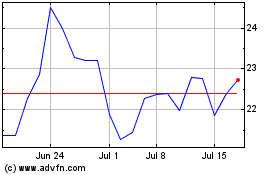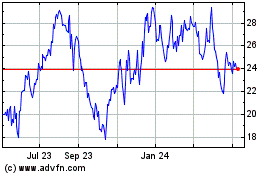More US Retailers Are Setting Their Sights On Canada
May 27 2011 - 4:21PM
Dow Jones News
Ample growth opportunities, a ready customer base and untapped
profit potential are expected to drive U.S. retailers into Canada
during the next couple of years.
The trip north is an easy way to mount international expansion
while keeping a very close eye on its progress. The similarity of
customers on both sides of the border makes big changes to stores
and merchandise generally unnecessary. And the idea of a less
crowded retail field eases competitive pressures and the
difficulties of finding new space in U.S. markets.
"The U.S. market is largely tapped out in terms of expansion
opportunity and consumer demand has softened," said Madison Riley,
managing director at retail consulting firm Kurt Salmon. "At the
same time, the Canadian economy did not suffer as much as ours and
there are virtually no regulatory hurdles."
This week saw two major retailers take big steps in their
Canadian expansion.: Target Corp. (TGT) on Thursday said it chose
105 sites for potential Canadian stores, which would be its first
international expansion. The locations were culled from 220 Zellers
leases it bought the rights for in January for C$1.8 billion, with
a second wave of selections to come in September. Target sees its
mix of groceries, apparel and home goods as a good fit for the many
Canadians who are price conscious, but seek value.
Also on Thursday, Big Lots Inc. (BIG) said it planned to buy
Canada-based closeout merchandiser Liquidation World Inc. (LQW.T)
for about C$1.8 million, also in its first move outside the U.S.
Big Lots plans to buy the 92 stores that Liquidation World operates
and "will probably get the opportunity to grow" the operation to
150 stores, Chief Executive Steve Fishman said.
Other U.S. retailers with plans to enter Canada include Express
Inc. (EXPR), which expects to open its first store in September and
have five to seven stores open by the end of January. The apparel
retailer, which operates 591 stores in the U.S., sees Canada as "a
location with wonderfully cosmopolitan cites and fashionable people
that's going to be a great market for us," spokeswoman Amy Hughes
said. The company believes it can have as many as 50 stores in
Canada in the next five years.
On the higher end, Nordstrom Inc. (JWN) is looking at sites in
Canada, but so far hasn't found a fit, spokesman Colin Johnson
said. The retailer said the majority of its online international
customers are Canadian and that many Canadian shoppers already
cross the border to visit its stores.
With a move into Canada, the companies would join a number of
U.S. retailers already doing business in the country, including
Wal-Mart Stores Inc. (WMT), Sears Holding Corp. (SHLD), Guess Inc.
(GES) and TJX Cos. (TJX).
TJX said it receives its highest financial returns from its
Canadian operations, where it has Winners, HomeSense, STYLESENSE
and, as of March, Marshalls stores, which the latter seen growing
to as many as 100 locations.
"We have found that Canadian customers are not very different
from those in the U.S.," TJX spokeswoman Sherry Lang said.
"Generally what plays in U.S. retail plays in Canadian retail;
customers really appreciate value."
U.S. mid-market department stores are one type of retailer that
have so far been quiet about heading north, despite chatter that it
is a logical next step for them.
Kohl's Corp. (KSS) has "a number of successful stores on the
Canadian border and will continue to assess opportunities to best
serve our customers in markets where we have backfill opportunity
and in markets not currently covered by the existing Kohl's store
base," spokeswoman Vicki Shamion said. "We will continue to explore
opportunities to gain market share through expansion when and where
it makes sense."
"While international stores remain a long-term interest of the
company, we have no current plans," Macy's Inc. (M) spokesman Jim
Sluzewski said.
A spokeswoman for J.C. Penney declined to comment, saying the
retailer has not publicly addressed the topic.
Canada does seem to offer a potential bounty, if U.S. retailers
execute well. Expressed in U.S. dollars, per-capita retail spending
in Canada is equal to the U.S. As recently as 2004, Canadians'
retail sales per capita were $8,000 while Americans' spending power
was 50% higher, at about $12,000 per capita, according to a study
by real estate brokerage Colliers International. The strong
Canadian dollar currently is also appealing, as are shopping center
sales that average $580 per square foot in Canada compared to $309
in the U.S., Colliers said.
-By Karen Talley, Dow Jones Newswires; 212-416-2196;
karen.talley@dowjones.com
Kohls (NYSE:KSS)
Historical Stock Chart
From May 2024 to Jun 2024

Kohls (NYSE:KSS)
Historical Stock Chart
From Jun 2023 to Jun 2024
